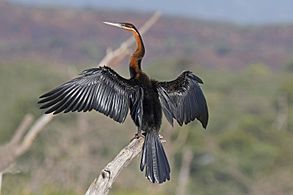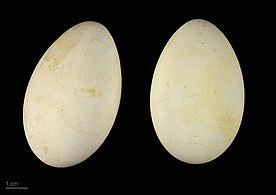African darter
| African darter | |
|---|---|

| |
| in Botswana | |
| Scientific classification | |
| Domain: | Eukaryota |
| Kingdom: | Animalia |
| Phylum: | Chordata |
| Class: | Aves |
| Order: | Suliformes |
| Family: | Anhingidae |
| Genus: | Anhinga |
| Species: | A. rufa
|
| Binomial name | |
| Anhinga rufa (Daudin, 1802)
| |

| |
| Distribution map | |
| Synonyms | |
|
Anhinga africana | |
The African darter (Anhinga rufa), sometimes called the snakebird, is a water bird of sub-Saharan Africa and Iraq.[1]
Taxonomy
The African darter is a member of the darter family,
Description
The African darter is 80 cm (31 in) long. Like other anhingas, it has a very long neck. The male is mainly glossy black with white streaking; females and immature birds are browner. The African darter differs in appearance from the American darter most recognisably by its thin white lateral neck stripe against a rufous background colour. The pointed bill prevents confusion with cormorants.
Distribution
The African darter is found throughout sub-Saharan Africa wherever large bodies of water occur; overall the species remains widespread and common.[1]
The only non-African
Behavior

This species builds a stick nest in a tree and lays 3–6 eggs. It often nests with herons, egrets and cormorants.
It often swims with only the neck above water, hence the common name snakebird. This, too, is a habit shared with the other anhingas. It feeds on fish, which it catches by diving.
Unlike many other waterbirds the feathers of the African darter do not contain any oil and are therefore not waterproof. Because of this, the bird is less positively buoyant and its diving capabilities are enhanced. After diving for fish, the feathers can become waterlogged. In order to be able to fly and maintain heat insulation, it needs to dry its feathers. Thus the African darter is often seen sitting along the waterside spreading its wings and drying its feathers in the wind and the sun along with cormorants, which may share its habitat.
Gallery
-
female
Ethiopia -
Anhinga rufa chantrei -MHNT
Bibliography
- Birds of The Gambia by Barlow, Wacher and Disley, ISBN 1-873403-32-1
- Birds of Southern Africa by Sinclair, Hockey, Tarboton, ISBN 978-1-86872-721-6
References
External links
- (African) darter - Species text in The Atlas of Southern African Birds.





